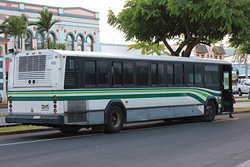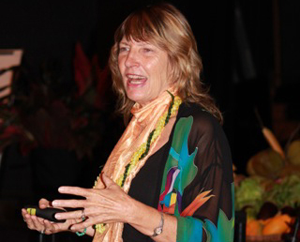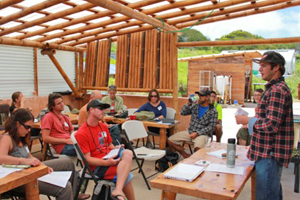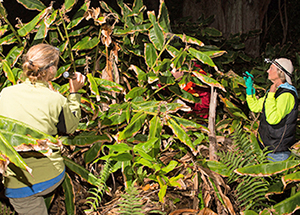Banding together to combat an invasive menace
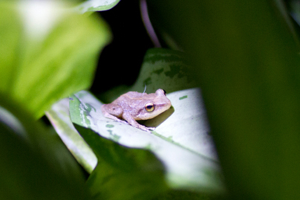
- A coqui frog emerges at night. The tiny, invasive frogs deprive native birds and bats of insects and can emit a high-pitched chirp of 90 to 100 decibels
Kathy Rawle was both disappointed and discouraged when she first heard the telltale “co-quee” chirp of the invasive coqui frog in her Waimea neighborhood one evening in June 2011. After hearing (quite literally) how the frog species had completely infested the east side of Hawai‘i Island, she thought there was no chance preventing it from taking over Waimea with its noisy and irritating nighttime call. When sharing her frustration with friend Melora Purell over lunch one day, she found a beacon of hope.
According to Rawle, “Melora told me it wasn’t hopeless at all. In fact, if we could take action right away, it could be quite the opposite.” Purell, the coordinator of Kohala Watershed Partnership, described the success community-based organizations in Volcano and North Kohala have had keeping the invasive frog at bay, despite the lack of funding from the state towards coqui-control efforts. Using her connections in the conservation world, Purell gathered information about the coqui frog, its origins (Puerto Rico), its habits (nocturnally noisy), and ways to catch and eliminate frogs (with patience and persistence).
Rawle organized a neighborhood meeting with neighbor Joyce O’Connor, and invited Ray McGuire, a Big Island Invasive Species Committee employee and coqui expert, to speak to the 20-plus Waimea residents who attended. That evening, they went searching for frogs, and caught their first coqui in a ginger patch. According to Rawle, “It was exhilarating! Removing just one frog makes a big difference… we helped prevent an infestation from taking hold.”
Coqui-Free Waimea (CFW) was officially established by Rawle, Purell, O’Connor, and Waimea Community Association president Sherm Warner in August 2011. The organization set up a hotline (808-313-1094) for Waimea residents to call to report frogs and receive guidance on how to eliminate them. Today, the hotline remains as active as ever.
The organization is completely funded by donations from Waimea community members. While residents have been generous with their financial support, CFW continues to seek donations to help support its frog-control efforts. CFW is primarily run by an advisory committee that helps make decisions about the direction of the organization and seeks input from the local community. Both Rawle and Purell remain key leaders within the committee.
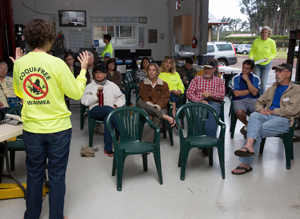
- Waimea residents convene for a briefing prior to a neighborhood frog hunt (Photo © Jonathan Rawle)
In May 2013, the organization hired community volunteer coordinator Tara Seely, who answers hotline calls, leads volunteer opportunities, and sends out email updates. A spraying technician, Jared Considine, joined the team in September 2013. Considine provides hands-on assistance with frog catching and citric acid-spraying efforts, the latter a method of eliminating frogs on a larger scale. Both employees are part time but make an effort to maximize the impact of the handful of hours they spend each week working for CFW. There also is a core group of dedicated volunteers that helps catch frogs and spray citric acid on volunteer nights.
Additionally, there are volunteers, led by O’Connor, who run CFW outreach booths at Waimea farmers markets and occasionally at KTA. According to O’Connor, “We’ve seen a shift in people’s attitudes over the years when they visit the outreach booths. They used to either be in denial that coqui frogs could survive the cold weather of Waimea, or think controlling frogs was a hopeless cause.” Now, she observes more support than ever. “People have realized the frogs are a very real threat to Waimea. We now hear stories all the time from people who have been going out on their own at night to catch frogs in their neighborhoods.”
CFW is currently focused on increasing its visibility within the community and fostering connections between Waimea residents who want to take action against coqui frogs. According to Seely, “Our work takes place at night, in the dark. People can’t really see how much we accomplish. We are going to get the message about volunteer opportunities out to more people this year. Not only do we want people to volunteer, but we want them to realize there are others out there constantly working on this problem.” Additionally, more neighbors will be notified when a frog is reported on their street. “We often get multiple reports of the same frog. I think people want to work with their neighbors, but they don’t know which ones to talk to. We can help with that; we can connect those people,” Seely said. These efforts all build up to CFW’s ultimate mission—to empower the community by sharing the skills and knowledge of frog removal and offering supplies and assistance when needed.
- Armed with flashlights, containers, and citric spray, Coqui-Free Waimea volunteers hunt the tiny frogs at night to keep the population at bay (Photo © Jonathan Rawle)
Leaving the comfort of one’s home in the evening to hunt for coqui frogs may seem daunting, yet Waimea residents should consider that coqui control can be more fulfilling than initially anticipated—even a bonding experience. According to Rawle, “The situation has been very positive for my neighborhood. I’ve gotten to know neighbors I rarely used to talk to. When it becomes a social activity, it’s actually fun to go out and look for frogs. It becomes enjoyable.”
Coqui-Free Waimea is not only helping Waimea preserve its peaceful, quiet nights, but it’s also turning the threat of an invasive species into an opportunity to build an even tighter-knit community.
For more information, visit coquifreewaimea.org. Waimea residents who hear coqui frogs on their streets are encouraged to call the CFW hotline at 808-313-1094.
Island youth expand their futures through university programs
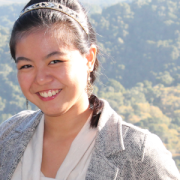
- 2014 Parker School graduate Lysha Matsunobu will begin her freshman year at Stanford University this fall
Many students who grow up and attend schools in Hawai‘i miss out on opportunities to travel and experience educational programs outside the state, primarily due to costs. Each year, The Kohala Center offers scholarships to Hawai‘i Island youth to attend leadership and academic programs at prestigious institutions in the continental United States. Often these experiences help students realize their potential and inspire them to pursue opportunities they never thought possible.
The programs, held at institutions such as Cornell University and Brown University, expose Hawai‘i Island students to leadership and academic development opportunities that catalyze greater achievement and new career aspirations.
Lysha Matsunobu, a 2014 graduate of Parker School in Waimea, exemplifies the pivotal power of a summer program. Through a Kohala Center scholarship, she participated in the Academic Connections program at University of California, San Diego, in 2011.
“My summer at UC San Diego is invaluable to me as I remember it as my starting point in exploring academics beyond my high school,” said Matsunobu. “I returned to self-study AP Environmental Science in my sophomore year confident with the knowledge I had gained from the course at UCSD.”
Matsunobu is one of 141 U.S. Presidential Scholars selected nationally based on their outstanding academic achievement, artistic excellence, leadership, citizenship, and contribution to school and community. She begins her undergraduate study at Stanford University this fall.
“By offering scholarships to Hawai‘i Island high school students to participate in these leadership programs at some of the world’s finest universities, we are inspiring island youth to push for excellence in their academic and future professional careers,” said Dr. Matthews Hamabata, President and CEO of The Kohala Center. “These opportunities help our youth expand their worldviews and envision future opportunities they might not otherwise be encouraged to pursue.” Himself born and raised in rural Hanapēpē, Kaua‘i, Hamabata went on to earn his undergraduate degree at Cornell, his doctorate at Harvard, and first taught at Yale University.
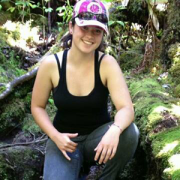
- KaMele Sanchez
This summer, two more students will receive scholarships from The Kohala Center to participate in programs at East Coast universities: KaMele Sanchez, a rising senior at Honoka‘a High & Intermediate School, and Kaila Alcoran-Gaston, a recent graduate of Ke Ana La‘ahana Public Charter School.
“This program gives me the opportunity to expand my knowledge and enhance my skills, so that I can come back home and share and help better my community,” said Sanchez, who will attend Cornell University’s CURIE Academy Program in Ithaca, New York. The CURIE Academy is a one-week residential engineering program for high school girls who excel in math and science.
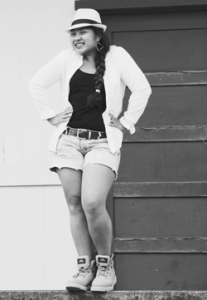
- Kaila Alcoran-Gaston
Alcoran-Gaston will attend the Brown Environmental Leadership Lab (BELL) program in Bristol, Rhode Island, which focuses on sustainable development through several academic disciplines, including biology, engineering, environmental science, and policy.
“I’m excited to learn about human demands on the environment and what can and cannot be compromised in terms of long-term detrimental effects on our ocean and coastline ecosystem. There are critical decisions to make at the community, county and state levels,” said Alcoran-Gaston. “I hope to learn how to contribute more knowledgeably to my own coastal community.”
To learn more about The Kohala Center’s academic and scholarship programs, go to https://kohalacenter.org/programs/academic.
Telling our story: The Kohala Center launches new website and program logos
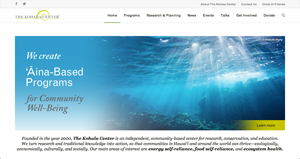
- Homepage of The Kohala Center’s new website at kohalacenter.org
For nearly 15 years, The Kohala Center has turned research and traditional knowledge into action, so that communities on Hawai‘i Island, across the state, and around the world can thrive—ecologically, economically, culturally, and socially. What started as a small, community-based project, driven by the soaring aspirations of island residents and leaders, grew into a robust organization offering many programs in the fields of energy self-reliance, food self-reliance, and ecosystem health. By launching a new website and giving our programs unique yet integrated identities, we are making it easier for more people to connect with not only what we do, but why we do it.
As The Kohala Center expanded over time and created new programs, investing in communications became a priority for the organization. “The Kohala Center has an incredibly unique history and track record of working toward a healthier Hawai‘i by building programs that celebrate and enhance Hawai‘i’s natural and cultural landscape—‘āina-based programs for community well-being,” said communications specialist Liam Kernell. “It’s a remarkable story of what an inspired community can do,” he continues. “But we haven’t always succeeded in communicating that our individual programs, customized to meet the needs of various communities, were part of a larger whole, part of a bigger, comprehensive effort to foster community well-being. An effort that requires holistic approaches and systemic change.”
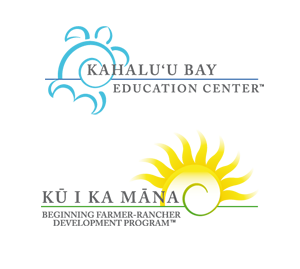
- The new logos for Kahalu‘u Bay Education Center and Kū I Ka Māna Beginning Farmer-Rancher Development Program. The Kohala Center’s creative team designed logos for six of The Center’s programs, using the organization’s iconic spiral to unify them.
After joining the organization in late 2012, one of Kernell’s first challenges was to evaluate The Center’s and each program’s messaging and marketing materials. With the help of Jessica Young, a Honoka‘a-based freelance graphic designer voted Best Graphic Artist by North Hawai‘i News five years in a row, the organization’s design standards were refreshed to convey a bolder, warmer, and professional image. Programs were also unified by connecting them to the same standards while creating unique color palettes for each. This spring, Kernell and Young collaborated with directors to create unique logos for each program, all united by a central design element: the spiral that has been the focal point of The Center’s logo since 2007.
“The spiral was created to represent many things: a Hawaiian tree snail, a seashell, a hapu‘u fern, as well as a breaking wave,” Kernell said. “It implies a living, growing, and dynamic entity with a focus on clarity, motion, and action—a fitting element for our ‘āina-based programs from mauka to makai (mountain to sea). Not only did we harness the spiral as an anchor between The Center and its programs, it also served as a muse throughout the logo development process.”
The new logos made their debut with the launch of the new kohalacenter.org in early May. Kernell and Young worked with Kenta Nemoto, an independent web designer and developer based in Āhualoa, to scope the overhaul of a site that was six years old and contained thousands of pages, documents, and images. “The ‘old’ site was practically held together with duct tape,” Nemoto jokes. “As new pages and sections were added to it, whole new sets of programming code were created, which made maintaining the site tedious. One of the core requirements we identified immediately was to create a centralized code base, making the new site—whether just a single page or every single page—easy to update with just a couple of clicks.” The team settled on the open-source WordPress content management system to serve as the “heart” of the site, which will allow for easy integration of new features and customization in the future. The development of the new site was made possible by a Hawai‘i Community Foundation FLEX grant.
“I’ve really enjoyed working with The Kohala Center because it supports efforts that align with my values, with leadership coming right from the communities in which we live and work,” Young said. “It’s fulfilling to contribute to positive and sustainable goals that are having a lasting impact on our islands. By applying aesthetics to help communicate valuable information, my work is furthering active, meaningful solutions.” Nemoto agreed, adding “It feels great to be able to use my skills towards positive change.”
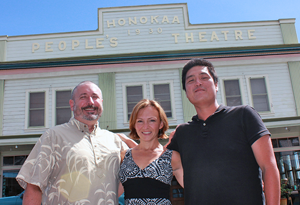
- (left to right) Liam Kernell, Jessica Young, and Kenta Nemoto. All residents of Honoka‘a, the team collaborates to deliver The Kohala Center’s printed and online communications.
Along with a cleaner interface, a simpler navigation structure, compatibility with mobile browsers, and improved integration with social media channels such as Facebook, the new website also features updated content to help site visitors understand the roots of The Center and its programs. 3Point Consulting, a communications, research, and planning firm on O‘ahu, facilitated an evaluation of The Center’s messaging and development of a comprehensive communications strategy. “3Point helped us realize that communicating why we do what we do is important,” Kernell said. “Communicating what we do and how we do it is only part of the picture. Why was The Kohala Center created in 2000? Why did we launch each of our programs? Doing so will help our supporters connect to the research and knowledge that inspires our work, and understand why it’s important to take action.”
Moving in to the second half of 2014, The Kohala Center will incorporate additional features into the website, as well as develop several online and mobile applications to support participatory action research projects for three of its agricultural programs. Tune in to future issues of The Leaflet as these projects launch later in the year.


